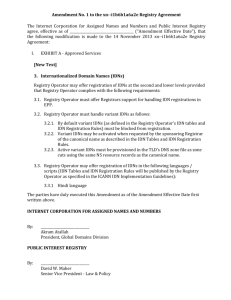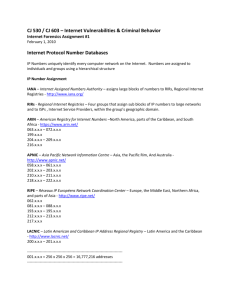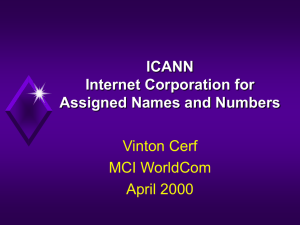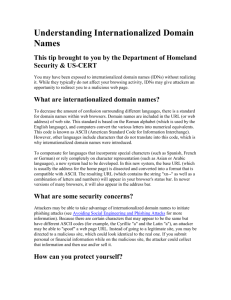NASK: at the cutting edge of technology Andrzej Bartosiewicz
advertisement
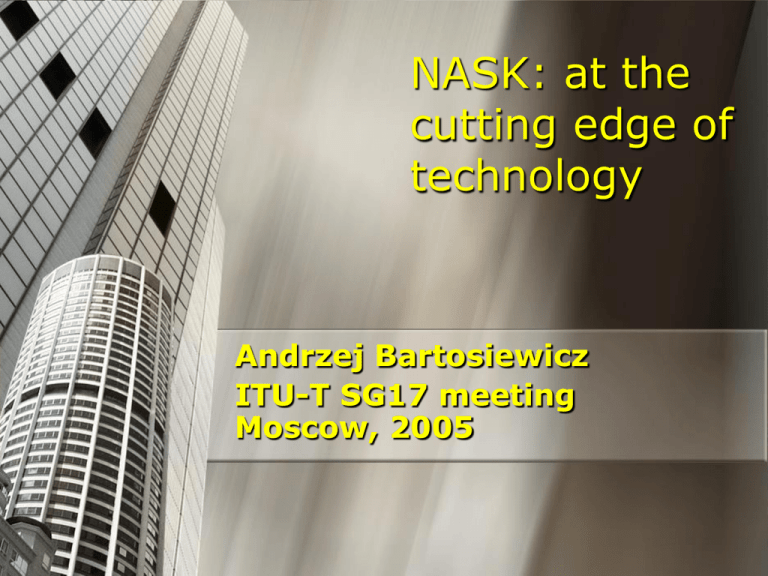
NASK: at the cutting edge of technology Andrzej Bartosiewicz ITU-T SG17 meeting Moscow, 2005 PART 1:Tutorial DNS resolution DNS (2) question: xn--wwz-hna2g.pl? (3) answer: IP (1) please, open page: „www.wąwóz.pl” (4) download the page. IDN versus ACE string www.kozłowski.pl www.xn--kozowski-8ob.pl overview of ICANN ICANN The Internet Corporation for Assigned Names and Numbers (ICANN) is a technical coordination body for the Internet. Created in October 1998 by a broad coalition of the Internet's business, technical, academic, and user communities, ICANN is assuming responsibility for a set of technical functions previously performed under U.S. government contract by IANA and other groups. Specifically, ICANN coordinates the assignment of the following identifiers that must be globally unique for the Internet to function: Internet domain names IP address numbers protocol parameter and port numbers In addition, ICANN coordinates the stable operation of the Internet's root server system. ICANN cont. As a non-profit, private-sector corporation, ICANN is dedicated to preserving the operational stability of the Internet; to promoting competition; to achieving broad representation of global Internet communities; and to developing policy through privatesector, bottom-up, consensus-based means. ICANN welcomes the participation of any interested Internet user, business, or organizat Source: http://www.icann.org/new.html ICANN documents General info http://www.icann.org/topics/idn.html IDN Language Table Registry http://www.iana.org/assignments/idn/ ICANN Statement on IDN Homograph Attacks and Request for Public Comment http://www.icann.org/announcements/ann ouncement-23feb05.htm overview of IETF IETF The Internet Engineering Task Force (IETF) is a large open international community of network designers, operators, vendors, and researchers concerned with the evolution of the Internet architecture and the smooth operation of the Internet. It is open to any interested individual. The actual technical work of the IETF is done in its working groups, which are organized by topic into several areas (e.g., routing, transport, security, etc.). Much of the work is handled via mailing lists. The IETF holds meetings three times per year. IETF cont. The IETF working groups are grouped into areas, and managed by Area Directors, or ADs. The ADs are members of the Internet Engineering Steering Group (IESG). Providing architectural oversight is the Internet Architecture Board, (IAB). The IAB also adjudicates appeals when someone complains that the IESG has failed. The IAB and IESG are chartered by the Internet Society (ISOC) for these purposes. The General Area Director also serves as the chair of the IESG and of the IETF, and is an exofficio member of the IAB. http://www.ietf.org/overview.html IETF documens Internationalizing Domain Names in Applications (IDNA) http://www.ietf.org/rfc/rfc3490.txt Nameprep: A Stringprep Profile for Internationalized Domain Names (IDN) http://www.ietf.org/rfc/rfc3491.txt Punycode: A Bootstring Encoding of Unicode for Internationalized Domain Names in Applications (IDNA) http://www.ietf.org/rfc/rfc3492.txt IDNs charter http://www.ietf.org/html.charters/idncharter.html role of ITU role of ITU Plenipotentiary Conference (Marrakesh 2002) Resolution 102: “Management of Internet Domain Names and Addresses” Resolution 133: “Role of administrations of Member States in the management of internationalized domain names” “Resolution 48 – Internationalized domain names” of The World Telecommunication Standardization Assembly (Florianópolis, 2004), Study Group 17 of ITU-T is instructed to study Internationalized Domain Names, and to continue to liaise and cooperate with appropriate entities in this area ITU documents RSS channel http://www.itu.int/osg/spu/newslog/categories /internationalizedDomainNames/ Introcution to IDNs by R.Shaw http://www.itu.int/osg/spu/presentations/2003 /ITU-moscow-presentation-idn.pdf Resolution 102 of Plenipotentiary Conference http://www.itu.int/osg/spu/resolutions/2002/re s102.html Resolution 133 of Plenipotentiary Conference http://www.itu.int/osg/spu/resolutions/2002/re splen5.html Resolution 48 of WTSA http://www.itu.int/ITUT/wtsa/resolutions04/Res48E.pdf technical background technical foundation The Internet Engineering Task Force (IETF) has approved documents which provide the technical foundation for handling domain names with Unicode characters (domain names which contain non-ASCII characters): RFC 3490 Internationalizing Domain Names in Applications RFC 3491 Nameprep: A Stringprep Profile for Internationalized Domain Names RFC 3492 Punycode: A Bootstring encoding of Unicode for Internationalized Domain Names in Applications IDNA (RFC 3490): example NAMEPREP (RFC 3491): KOZŁOWSKI.pl kozłowski.pl PUNYCODE (RFC 3492): kozłowski.pl kozowski-8ob.pl Prefix: xn-kozowski-8ob.pl xn--kozowski-8ob.pl types of IDNs Basic types of IDNs: ML.ASCII Multilingual.ASCII Domain Names (ccTLD or gTLD) ML.ML Multilingual.Multilingual (ccTLD or gTLD) ICANN guidelines ICANN guidelines 1. Top-level domain registries that implement internationalized domain name capabilities will do so in strict compliance with the technical requirements described in RFCs 3490, 3491, and 3492 (collectively, the "IDN standards"). 2. In implementing the IDN standards, top-level domain registries will employ an "inclusion-based" approach (meaning that code points that are not explicitly permitted by the registry are prohibited) for identifying permissible code points from among the full Unicode repertoire. ICANN guidelines 3. In implementing the IDN standards, top-level domain registries will (a) associate each registered internationalized domain name with one language or set of languages, (b) employ language-specific registration and administration rules that are documented and publicly available, such as the reservation of all domain names with equivalent character variants in the languages associated with the registered domain name, and, (c) where the registry finds that the registration and administration rules for a given language would benefit from a character variants table, allow registrations in that language only when an appropriate table is available. ICANN guidelines 4. Registries will work collaboratively with relevant and interested stakeholders to develop language-specific registration policies (including, where the registry determines appropriate, character variant tables), with the objective of achieving consistent approaches to IDN implementation for the benefit of DNS users worldwide. Registries will work collaboratively with each other to address common issues, through, for example, ad hoc groups, regional groups, and global fora, such as the ICANN IDN Registry Implementation Committee. ICANN guidelines 5. In implementing the IDN standards, top-level domain registries should, at least initially, limit any given domain label (such as a second-level domain name) to the characters associated with one language or set of languages only. 6. Top-level domain registries (and registrars) should provide informational resources and services in all languages for which they offer internationalized domain name registrations. URI and IRI Uniform Resource Identifier A Uniform Resource Identifier (URI) is a compact sequence of characters that identifies an abstract or physical resource. This specification defines the generic URI syntax and a process for resolving URI references that might be in relative form, along with guidelines and security considerations for the use of URIs on the Internet. RFC 3986 examples of URI ftp://ftp.is.co.za/rfc/rfc1808.txt http://www.ietf.org/rfc/rfc2396.txt ldap://[2001:db8::7]/c=GB?objectCl ass?one mailto:John.Doe@example.com news:comp.infosystems.www.server tel:+1-816-555-1212 telnet://192.0.2.16:80/ urn:oasis:names:specification:docbo ok:dtd:xml:4.1. Internationalized Resource Identifiers Internationalized Resource Identifiers (IRIs) are a new protocol element, a complement to URIs. An IRI is a sequence of characters from the Universal Character Set (Unicode/ISO10646). There is a mapping from IRIs to URIs, which means that IRIs can be used instead of URIs where appropriate to identify resources. RFC 3987 IDN aware applications web browsers Camino URL: http://www.mozilla.org/products/camino/ Epiphany URL: http://www.gnome.org/projects/epiphany/ Firefox URL: http://www.mozilla.org/products/firefox/ Galeon URL: http://galeon.sourceforge.net Konqueror URL: http://www.konqueror.org/ Mozilla URL: http://www.mozilla.org/products/mozilla1.x/ Netscape URL: http://www.netscape.com Opera URL: http://www.opera.com Safari URL: http://www.apple.com/safari/ e-mail / ftp Foxmail URL: http://fox.foxmail.com.cn FTP Core URL: http://www.coreftp.com Voyager FTP URL: http://www.ftpvoyager.com Secure FTP URL: http://www.securenetterm.com Smart FTP URL: http://www.smartftp.com other i-Nav™ and Components URL: http://www.idnnow.com Applications Supported: Internet Explorer 5.0 and higher; Microsoft Outlook 2000, 2002 (XP), 2003; Outlook Express 5.0 and higher Web-based E-mail Support: Hotmail, Yahoo(.com,.jp,.cn.,.kr) , Daum, Netease(163.com) Source: Verisign technical problems variants The variant(s) are the character(s) and/or string(s) that are equivalent to the base character. Note that these might not be true equivalent characters: a base character might have a mapping to a particular variant character, but that variant character does not have to have a mapping to the base character. Source: „A Method for Registering Internationalized Domain Names” P.Hoffman bundles A "registration bundle" is the set of all labels that comes from expanding the base characters for a single name into their variants. A registry has three options for how to handle the case where the registration bundle has more than one label. The policy options are: Resolve all labels in the zone, making the zone information identical to that of the registered label. Block all labels other than the registered label so they cannot be registered in the future. Resolve some labels and block some other labels. Source: „A Method for Registering Internationalized Domain Names” P.Hoffman registration policy Registration policy can be divided in three main categories: Restrictions based on „Code Pages”, Restrictions based on „Code Points” requred by languages (one or more languages), No restrictions. to do list already done… IDN Standards (RFCs) - ready ICANN IDN Guidelines - ready web browsers – ready, except IE supported by many ccTLDs and gTLD to do… Internationalized Resource Identifiers e-mail applications web browsers – Interner Explorer IDN in Digital Certificates IDN over EPP (if applicable) Interner Explorer and… general acceptance worldwide! general info PART 2: Polish experience NASK: background established in 1993 R&D entity ITU-T Sector Member: since October 2004 registry for .PL registry for +48 ENUM ISP/TSP (hosting, Internet Acces, IP Transit, corporate networks, videoconference, VoIP services) 280 employees (total) technological success story March 2003: EPP (the first registry in Europe) September 2003: IDNs (the first registy in Europe) March 2004: ISO 9001:2000 (the first ccTLD registry all over the world with ISO 9001 in the field of domain names) May 2004: EPP for ENUM (the first national ENUM registry all over the world with EPP registry system) April 2004: Wait List Service („options”) implementation history of IDNs February 2002 – February 2003: Consultations with LIC Press conferences, press releases Consultations and discussions with European ccTLD Registries Preliminary presentations during CENTR Administrative Workshop, CENTR Technical Workshop. March 2003: IETF RFC 3490, 3491 and 3492 August the 11th, 2003: NASK’s IETF draft launch date: September the 11th, 2003 history of IDNs September the 11th, 2003: Polish script (under .pl) September the 18th, 2003: +Polish script under 2nd level October the 6th, 2003: +Germans characters October the 20th, 2003: +Latin 1 Supplement and Latin Extended-A November the 3rd, 2003: +Greek February the 26th, 2004: +Cyrillic IDN rules First Come, First Served method, no pre-registrations, no „sunrise” period, ACE version only for input, output, processing, NASK accepts only valid ACE strings according to RFC 3490, 3491, 3492, “xn--” is the only accepted prefix for ACE domain names, IDN rules no special rules for ACE domain names combination of characters from different character sets is not allowed no variants no bundling no association with languages – - no “language tags” no changes to internal databases, protocols (EPP), invoicing, procedures, customer care etc. statistics registrations (weekly) 1800 1600 1400 1200 1000 800 600 400 200 0 1 2 3 3 4 5 5 5 6 8 8 9 0 0 1 2 2 2 3 4 4 5 6 6 7 7 0 -1 0-0 0-2 1-1 2-0 2-2 1-1 2-0 2-2 3-1 4-0 4-2 5-2 6-1 7-0 7-2 8-1 9-0 9-2 0-1 1-0 1-2 2-1 1-0 1-2 2-1 3-1 9 0 1 1 1 1 1 0 0 0 0 0 0 0 0 0 0 0 0 0 1 1 1 1 0 0 0 0 3- 03- 03- 03- 03- 03- 04- 04- 04- 04- 04- 04- 04- 04- 04- 04- 04- 04- 04- 04- 04- 04- 04- 05- 05- 05- 050 20 20 20 20 20 20 20 20 20 20 20 20 20 20 20 20 20 20 20 20 20 20 20 20 20 20 20 20 0 20 3-0 0 9 20 3-1 -11 0 0 20 3-1 -02 0 0 20 3-1 -23 0 1 20 3-1 -13 0 2 20 3-1 -04 0 2 20 4-0 -25 0 1 20 4-0 -15 0 2 20 4-0 -05 0 2 20 4-0 -26 0 3 20 4-0 -18 0 4 20 4-0 -08 0 4 20 4-0 -29 0 5 20 4-0 -20 0 6 20 4-0 -10 0 7 20 4-0 -01 0 7 20 4-0 -22 0 8 20 4-0 -12 0 9 20 4-0 -02 0 9 20 4-1 -23 0 0 20 4-1 -14 0 1 20 4-1 -04 0 1 20 4-1 -25 0 2 20 5-0 -16 0 1 20 5-0 -06 0 1 20 5-0 -27 05 2-0 17 310 registrations (cumulative) 6000 5000 4000 3000 2000 1000 0 IDN stats 2% 98% < 2% IDNs > 98% ASCII security homograph attacks NASK prevents existing registrants from homograph attacks: different script mixing (for example characters from Cyrillic and Latin script) is not allowed under .pl registration of domain names in Cyrillics similar to existing Latin domain names is not allowed andrzej.bartosiewicz @ nask.pl www.bartosiewicz.pl
